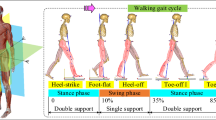Abstract
Rehabilitation training is the most effective way to reduce motor impairments in stroke patients, and cable-driven robots can be an efficient way to increase the intensity of this training. The motor functions of stroke patients are often related and evaluated using circle drawing/tracing tasks as studies show that these patients produce elliptical instead of circular shapes. Training can increase the hemiparetic arm workspace and the performance of circular design in these patients. Thus, this paper presents a robot actuated by cables that can be used in rehabilitation producing circular trajectories. First, the circular trajectory and mathematical model to keep the cables in tension are presented. Next, a serious game is described that uses the circular trajectory for stroke rehabilitation. The results showed that the predictive equation proposed in the present paper represented the experimental data with an average relative error of only 1%. Finally, an optimization was performed to obtain the shortest period of a circular trajectory.











Similar content being viewed by others
References
Tappeiner L, Ottaviano E, Husty ML (2018) A cable-driven robot for upper limb rehabilitation inspired by the mirror therapy. In: Zeghloul S, Romdhane L, Laribi M (eds) Computational kinematics, vol 50. Mechanisms and machine science. Springer, Cham
Hatem SM, Saussez G, DellaFaille M et al (2016) Rehabilitation of motor function after stroke: a multiple systematic review focused on techniques to stimulate upper extremity recovery. Front Human Neurosci 10:1–22
Gonçalves RS, Krebs HI (2017) MIT-Skywalker: considerations on the design of a body weight support system. J NeuroEng Rehabilit 14:88
Mao Y et al (2015) Human movement training with a cable driven ARm EXoskeleton (CAREX). IEEE Trans Neural Syst Rehabilit Eng 23:1
Beyl P et al. (2009) Safe and compliant guidance in robot-assisted gait rehabilitation using proxy-based sliding mode control. In: IEEE 11th international conference on rehabilitation robotics, Japan
Barbosa AM, Carvalho JCM, Gonçalves RS (2018) Cable-driven lower limb rehabilitation robot. J Brazilian Soc Mech Sci Eng 40:245
Alves T, D’Carvalho MC, Gonçalves RS (2018) Assist-as-needed” control in a robotic structure driven by cables for rehabilitation of human body joints, ENEBI 2018. Águas de Lindóia, Brazil
Gonçalves RS, Lobato FS, Carvalho JCM (2016) Design of a robotic device actuated by cables for human lower limb rehabilitation using self-adaptive differential evolution and robust optimization. Biosci J (Online) 32:1689–1702
Gonçalves RS, Carvalho JCM, Ribeiro JF, Salim VV (2015) Cable-driven robot for upper and lower limbs rehabilitation. In: Habib MK (ed) Handbook of research on advancements in robotics and mechatronics, 1st edn. IGI Global, Hershey, pp 284–315
Schmidt RA et al (2018) Motor control and learning: a behavioral emphasis, 6th edn. Human Kinetics Publishers, Champaign
Ceccarelli M, Romdhane L (2010) Design issues for human-machine platform interface in cable based parallel manipulators for physiotherapy applications. J Zhejiang Univ Sci A 11(4):231–239
Gonçalves RS, Carvalho JCM, Rodrigues LAO, Barbosa AM (2013) Cable-driven parallel manipulator for lower limb rehabilitation. Appl Mech Mater 459:535–542
Dipietro L, Krebs HI, Fasoli SE et al (2007) Changing motor synergies in chronic stroke. J Neurophysiol 98(2):757–768
Hussain A, Budhota A, Contu S et al (2017) “Quantitative assessment of motor functions post-stroke: Responsiveness of upper-extremity robotic measures and its task dependence. In: IEEE international conference on rehabilitation robotics, pp 1037–1042
Krabben T, Prange GB et al (2012) Influence of gravity compensation training on synergistic movement patterns of the upper extremity after stroke, a pilot study. J NeuroEng Rehabilit 9:44
Murphy G (1950) Similitude in engineering. Ronald Press, New York
Rosati G, Masiero S, Rossi A (2017) On the use of cable-driven robots in early inpatient stroke rehabilitation. In: Boschetti G, Gasparetto A (eds) Advances in italian mechanism science: proceedings of the first international conference of IFToMM Italy. https://doi.org/10.1007/978-3-319-48375-7
Alves T, D’Carvalho MC, Gonçalves RS (2019) Assist-as-needed control in a cable-actuated robot for human joints rehabilitation. J Mech Eng Biomech 5(3):57–62
Appel VCR et al (2014) Classifying emotions in rehabilitation robotics based on facial skin temperature. In: 5th IEEE RAS EMBS international conference on biomedical robotics and biomechatronics, p. 276
Moretti CB, Andrade KO, Caurin GAP (2014) Physiotherapy support web-based system for rehabilitation robotics: an initial architecture. In: ABCM symposium series in mechatronics, Vol. 6. Part I-international congress. Section IV-Robotics
Dempster WT, Gaughran GRL (1889) Properties of body segments based on size and weight. Am J Anat 18(7414):33–54
Hassanien AE, Emary E (2016) Bat Algorithm (BA). Swarm intelligence—principles advances, and applications. CRC Press, Boca Raton, pp 15–41
Author information
Authors and Affiliations
Corresponding author
Additional information
Technical Editor: Adriano Almeida Gonçalves Siqueira.
Publisher's Note
Springer Nature remains neutral with regard to jurisdictional claims in published maps and institutional affiliations.
Rights and permissions
About this article
Cite this article
Alves, T., Gonçalves, R.S. Predictive equation for a circular trajectory period in a cable-driven robot for rehabilitation. J Braz. Soc. Mech. Sci. Eng. 42, 279 (2020). https://doi.org/10.1007/s40430-020-02309-2
Received:
Accepted:
Published:
DOI: https://doi.org/10.1007/s40430-020-02309-2




